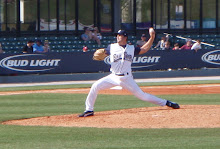 fastballs as the are released from our hand. We also know that the longer it take sa hitter to realize the pitch isn't a fastball, the less chance he has to hit that pitch. What is one of the toughest pitches to recognize, you ask? The answer is slider my friends. (Let me qualify this statement by saying the toughest pitch to hit by itself may well be a change-up, but I've chose slider here for its fastball-like qualities).
fastballs as the are released from our hand. We also know that the longer it take sa hitter to realize the pitch isn't a fastball, the less chance he has to hit that pitch. What is one of the toughest pitches to recognize, you ask? The answer is slider my friends. (Let me qualify this statement by saying the toughest pitch to hit by itself may well be a change-up, but I've chose slider here for its fastball-like qualities). The reason the slider is so tough to hit is because its velocity difference is very similar to a fastball (usually 5 mph slower or less) and the trajectory is very similar to that of a fastball. In fact, the straighter a slider is until it gets to the plate, the better. A true slider will only move down and glove side about 6 to 9 inches and only a begin to 'slide' a few feet before the plate. Some of the best pitchers in the game today utilize their slider most frequently. Fan graph.com explains that in 2008 Armando Gallaraga used his slider 38% of the time, with Randy Johnson not far behind (35%) and Ervin Santana in third (33%). Of course, some of this is due to the type of pitcher they are and pitch selection. But it also shows just how valuable is the slider.
Visualize the slider from a hitter's perspective. A slider thrown by a right handed pitcher away to a righty will look like an outside fastball. Generally, a hitter will look to drive the fastball away and swing accordingly. As the hitter starts his swing, the slider darts down and away - usually resulting in a swing and miss. On the flip side, a slider thrown right at the batters hip will look like a fastball that will miss inside for a ball; only to have it break over the middle of the plate for a called strike (this is known as a backdoor slider).
So, how do we throw this mythical pitch? Well, like a fastball for about 90% of the delivery. The grip should be one with index and middle finger close together across the seams (see picture)
 and the mechanics and hand-speed should be identical to a fastball. With fingers on top of the ball as it gets to release point (as the arms passes by the head) you will turn "thumb to face" with the index and middle finger pointing down - similar to turning a knob on a door - as you release the ball. The harder the pitch is thrown, the straighter it will stay and less it will move (although this is generally the idea with the slider). The follow through is slightly across the body and down. Notice there is no "snapping" or turning of the wrist like many were taught in little league. When thrown correctly, the slider is a safe pitch to throw.
and the mechanics and hand-speed should be identical to a fastball. With fingers on top of the ball as it gets to release point (as the arms passes by the head) you will turn "thumb to face" with the index and middle finger pointing down - similar to turning a knob on a door - as you release the ball. The harder the pitch is thrown, the straighter it will stay and less it will move (although this is generally the idea with the slider). The follow through is slightly across the body and down. Notice there is no "snapping" or turning of the wrist like many were taught in little league. When thrown correctly, the slider is a safe pitch to throw. So there you have it. The slider in a nut shell. Please post any questions you may have and I will better explain one of the toughest pitches to hit in the game.

Isn't a true backdoor slider one that starts outside, then breaks back over the outside corner of the plate? I.E. a lefty throwing a pitch to a right handed batter that starts outside, then comes back across the outside corner.
ReplyDeletethat is also a back door slide., in fact, you are technically correct - the true back door slider starts outside and then finishes breaking across the corner for a strike. I would point out though, that the scenario I described has the same affect (i.e. a slider that looks like a ball at first, and then breaks in)
ReplyDeleteThanks for the comment and good point!!
I see what you're saying, keep up the good work, my son is working on his slider and the technique you described is working well, getting much tighter spin and late break.
ReplyDeletethats great to hear, keep checking out the blog for all kinds of info - especially study those big leaguer breakdowns i do on the weekends.
ReplyDeleteif you're ever in williamsburg, va, I'll be teaching lessons at the indoor facility there.